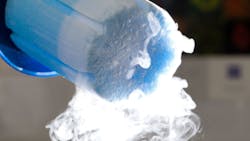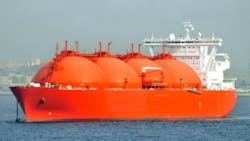There are particular demands on steel castings to be used in low-temperature applications, those that must withstand temperatures down to -196 °C (-321°F.) To date, austenitic steels have been used in such products, however because of their low yield strength these products are subject to the risk of early deformation, so they must be cast with very thick walls. This was the starting point for the development of a new low-temperature material -- Dux Cryo® -- that displays significantly higher strength values with good toughness.
The practical advantage is that castings produced with the new alloy can be designed with thinner walls, which saves weight but as well as costs.
Instead of austenitic steel, Schmolz + Bickenbach Guss recently started to use martensitic steels for jobs in the low-temperature range. This was the result of an extensive research project funded by the German Federal Ministry of Economics and Technology (BWMi).
S+B Guss produces castings for energy markets, steelmaking equipment, rolling mills and tube mills, mechanical and plant engineering, automotive tooling, pumps and accessories, as well as art casting. It pours high-temperature and low-temperature steels, corrosion- and acid-resistant steels, duplex and super duplex steels, nickel-based and Ni-Cu alloys, and tool steels.
The metalcasting group detailed that its new martensitic materials are well suited for tempering and therefore also display significantly higher yield strength (Rp0.2 ³490 N/mm²)than the alternative of austenitic steels -- a property that is particularly advantageous in extreme temperatures.
However, particular demands are placed not only on the strength but also on the toughness (KV (-196°C) ³40 J). The prerequisite for high strength at low temperatures is primarily a low content of selected trace elements. Otherwise, the segregations caused result in embrittling of the casting.
“For us, the challenge lay in achieving reliable manufacture of the castings with a focus on optimised structure and therefore adequate strength – without cracks appearing in the casting volume,” explained Dr. Petra Becker, who leads research & development at Schmolz + Bickenbach Guss.
Extensive Development Work
The starting point for the research project was the low-temperature material X8Ni9, which is used as a standard sheet and forging material for applications down to -196 °C. However, due to the high cracking sensitivity of the coarse-grained primary structure, no casting alternative to the material existed previously.
The aim was to present the material as a casting modification by combining findings from analytics, metallurgy and heat treatment. In addition to extensive materials testing and comprehensive literature research, this also involved co-operation with external experts.
The latest technologies were used here, e.g. a casting technology simulation, thermodynamic calculations of the material and heat treatment, and the latest methods of analysis for the investigation results. Consequently, one of the findings was that the requirements in terms of purity of the input substances, and in terms of melting and shaping technology, are particularly important.
Additionally, the heat-treatment parameters must be set extremely precisely. Based on the findings, experimental production was undertaken, from melting and casting through heat treatment to mechanical testing.
After casting, the castings were subjected to extensive checks. In addition to visual and color penetration checks, these included ultrasound and x-ray examinations. It was possible to demonstrate here that the alloying concept together with the selected cooling conditions really does produce crack-free castings.Furthermore, a series of heat treatment tests took place in order to optimize the mechanical values.
The new, low-temperature material, Dux Cryo, is the result of these tests. It delivers increased yield strength and outstanding low-temperature strength, and therefore finished castings can be designed and produced with significantly thinner walls. This allows greater design freedom, saves on weight and costs, and conserves resources.
“Because of the chemical composition, the new material is more advantageous than austenite – with a similar nickel content, it contains no chromium,” Becker specifies. A further advantage: it can be mechanically processed with no problem.
Various Applications
The new material is suitable for all areas in which work is carried out at temperatures between -100°C and -196°C (-212°F to -321°F), and therefore wherever cryogens such as dry ice or liquid oxygen and nitrogen are used. This applies including for air liquefaction and separation systems, in which air components are separated using thermal separation processes to extract nitrogen, oxygen, argon and other noble gases in high-purity concentration as well as in liquid and gaseous form.
Another application with a promising future is the liquefaction of natural gas: here, the natural gas is cooled to as low as -164 °Cin so-called LNG terminals – the demands on the components used are accordingly also high. Similar demands apply for cold grinding and cryogenic recycling. These processes are used e.g. in the food industry and in the area of composite materials. The aim here is the grinding of materials with a low softening point.
“This material could also have interesting potential in the areas of soil freezing, industrial refrigeration technology and oil sands extraction,” Dr Becker expounded. The same applies for all components that are used at low external temperatures, whether pumps in Alaska or deep-sea offshore applications.


